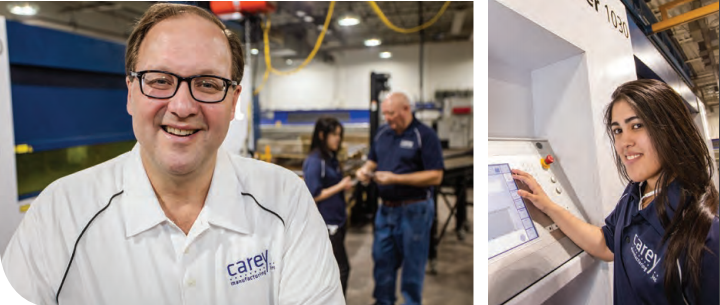TRUMPF EXPRESS: MAGAZINE FOR SHEET METAL PROCESSING IN NORTH AMERICA
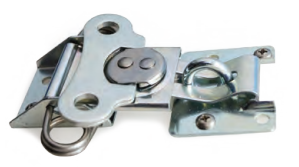
Carey Manufacturing found it could bring its manufacturing back to Connecticut, be profitable, and best support customer demands by relying on the right equipment.
When Jack Carey established Carey Manufacturing he had just six hundred square feet to run his business. His company now fills a 30,000 square foot facility in Cromwell, Connecticut and offers nearly 800,000 types of catches, latches, handles, knobs and hardware for use in military, aerospace, computer, electronics, telecom, automotive, and consumer applications worldwide. Until recently, it made many of these products in China where manufacturing costs were just thirty percent of what they were in the United States. However, unpredictable quality led Carey to reconsider his approach and to invest in precision fabricating equipment from TRUMPF. “Our production costs are now very close to what China can offer – but we make the parts faster and better. We also benefit from the flexibility of the machines and what that enables for our business,” explains Jack Carey, President of Carey Manufacturing. Despite the higher cost of engineering and capital equipment, Paul Lavoie, who manages Carey’s marketing and business development says, “Our improved customer service, greater efficiencies and other residual benefits have made us competitive across the globe.” Lavoie uses a recent example to illustrate this point. “Last Monday a customer called us with a problem. We manufactured samples and shipped them overnight so they were on the manufacturing floor the next day. We implemented a few tweaks and by Thursday we shipped the order. That process would have taken us several weeks if we still went overseas – and that customer would have bought elsewhere,” Lavoie asserts.
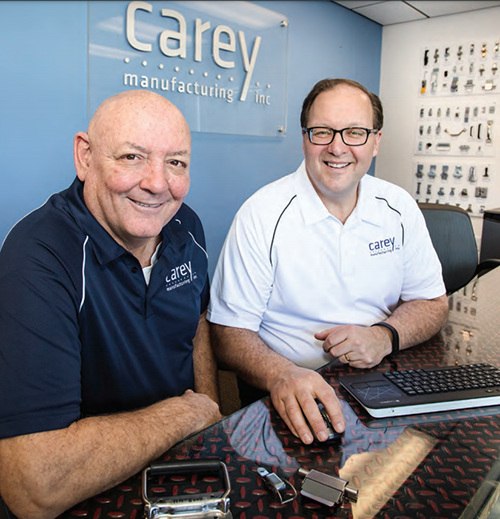
BUILDING CAPABILITIES Carey Manufacturing invested in a TRUMPF TruBend 5130 press brake several years ago, and recently acquired a TRUMPF TruLaser 1030 fiber and a TruMatic 7000 combination punch laser machine. “We offered some basic CNC machining at that point and a request came in that required more than we could offer in cutting. We reached out to TRUMPF and our sales rep, Lukas Baechler, came by that afternoon to show us the options. That’s when the wheels started turning,” explains Carey. The combination machine was especially enticing for its overall flexibility. “Punching is our bread and butter, but the laser enables us to do things nobody else can do.” Carey estimates the TruMatic now processes 1,800 to 2,600 parts from a standard 4 x 8 foot sheet and it currently runs 24/7, even though the company has yet to transition all of its products to the new machine. “We are able to fabricate almost all the forms and bends required for our products even though we are only in our infancy when it comes to tooling,” says Carey. “We have found ways to work around our limitations and we continue to learn as we go along.” The TruBend 5130 also turned out to be an important tool as Carey worked to bring manufacturing back from China. “Many of our parts are small enough for the small electric press brake, but I wanted the larger machine so we would always have the size and press force if we need it.” Since then the company has found innovative ways of using the equipment in support of its product designs, which include Winchester and USECO handles and knobs and Amatom hardware. Unique tools further enable the company to process several parts at once to increase efficiency. The company currently manufactures three hundred of its part numbers in Connecticut and this continues to grow by the day. Stainless steel and mild steel parts were the first priority but many aluminum parts have been transitioned as well. Since Carey often adjusts its standard products to fit a customer’s application, its part numbers continue to grow as well. “The market has really changed over the past few years to a point where customers expect at least some tweaks to the design,” says Carey. “Luckily we can turn a project around in just a few weeks or less – and that includes all the engineering, design, tooling and testing. Once the hard work is done we can change parts over in about fifteen minutes. All of that came together with our new machinery,” says Carey.
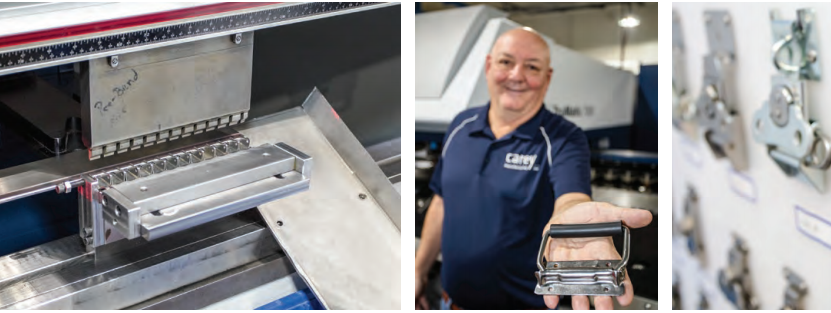
Punching is our bread and butter, but laser enables us to do things nobody else can do.
OPERATIONAL EFFICIENCY Manufacturing in Connecticut has also benefited Carey Manufacturing from an operations standpoint. In the past the company typically sourced parts from China in quantities of 100,000, but since its customers order just 5,000 to 10,000 parts at a time there was waste in storage, transportation, and handling. “Parts in inventory are expensive to carry and every time you handle them it costs the company money. By keeping inventory to a minimum we can improve operations, cash flow and profitability,” explains Lavoie. These improved efficiencies are especially noticeable in Carey’s high transaction business. “We do $8 million a year in sales from items like fasteners, catches and latches. Our purchase orders tend to be for less than a thousand dollars which means we process a substantial number each day and quick turnaround is the expectation – of any business today,” says Lavoie.
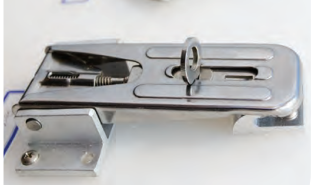
Carey has brought more manufacturing inhouse while providing a quicker turnaround for its customers and has been able to do so profitably. The difficulty, according to Carey, is that foreign governments offer extensive subsidies which keep their manufacturing companies afloat and U.S. manufacturers struggling to compete. As a result, as Carey reveals, “Many consumers – including our military – think they are buying U.S. products without realizing their supplier has outsourced the manufacturing work while American hands barely touch the process.”
In the meantime, Carey Manufacturing has found a solution that works for its business. They are working hard to transition more products for production in Connecticut while also streamlining its sales and marketing efforts. In addition, the TruLaser 1030 fiber has opened up extra capacity for contract work which the company is looking to fill. “Most of our own work is not strictly laser cut so we can easily cut flat patterns for those who either do not have the capabilities or who just prefer to focus on downstream processing,” Carey explains. He expects contract work will become a bigger focus in the future but at the moment, the company has so much work to do they need to figure out how to get it all done. But as both Carey and Lavoie agree, that is a great problem to have.
